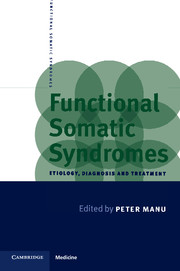Crossref Citations
This Book has been
cited by the following publications. This list is generated based on data provided by Crossref.
Terr, Abba I.
2000.
CONTROVERSIAL FORMS OF IMMUNOTHERAPY.
Immunology and Allergy Clinics of North America,
Vol. 20,
Issue. 3,
p.
643.
De Gucht, V.
2002.
Neuroticism, alexithymia, negative affect and positive affect as predictors of medically unexplained symptoms in primary care.
Acta Neuropsychiatrica,
Vol. 14,
Issue. 4,
p.
181.
De Gucht, Véronique
Fischler, Benjamin
and
Heiser, Willem
2003.
Job stress, personality, and psychological distress as determinants of somatization and functional somatic syndromes in a population of nurses.
Stress and Health,
Vol. 19,
Issue. 4,
p.
195.
TANIKAWA, Hirotaka
2007.
A Case of Pain of Musculoskeletal system Treated by Psychosomatic Approach.
JOURNAL OF THE JAPANESE ASSOCIATION OF RURAL MEDICINE,
Vol. 56,
Issue. 4,
p.
643.
Terr, Abba I.
2009.
Sick Building Syndrome: is mould the cause?.
Medical Mycology,
Vol. 47,
Issue. s1,
p.
S217.
Ortega, Francisco
and
Zorzanelli, Rafaela
2011.
Imagens cerebrais e o caso da síndrome da fadiga crônica.
Ciência & Saúde Coletiva,
Vol. 16,
Issue. 4,
p.
2123.
Pietikainen, Petteri
and
Turunen, Jari
2017.
Diagnoses in and out of time: historical and medical perspectives on the diagnoses of distress.
Diagnosis,
Vol. 4,
Issue. 1,
p.
3.
Okur Güney, Zeynep Emine
Sattel, Heribert
Witthöft, Michael
Henningsen, Peter
and
Barca, Laura
2019.
Emotion regulation in patients with somatic symptom and related disorders: A systematic review.
PLOS ONE,
Vol. 14,
Issue. 6,
p.
e0217277.



